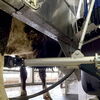Processing Your Payment
Please do not leave this page until complete. This can take a few moments.
Merging members | A push to combine two chambers could mean more might for the midcoast
The offices of the Penobscot Bay Chamber of Commerce and the Camden-Rockport-Lincolnville Chamber of Commerce are a mere eight miles apart. The former pegs itself “The Real Maine,” while the latter proclaims it the “Jewel of the Maine Coast.” Each has around 630 members, a third of which they share.
Soon, they could be sharing a lot more. After two years of research on ways to collaborate, the boards of both chambers in February proposed a merger to reduce redundant efforts and better market the region. Though their separate offices would remain in place, other resources would be pooled — staff, technology, expertise, budgets. Chamber officials and advocates say joining forces would allow the chambers to expand services to members, increase promotion efforts and give members more value for their dollar.
And while the boards studied a number of ways to collaborate or share resources, the idea of a full merger rose to the top, says Dan Bookham, executive director of the CRL chamber. “It became apparent pretty quickly that, among all the options, this would probably be our strongest cards to play,” he says.
Under the proposed merger, the chamber would be led by a board of directors, an executive director and a director of operations. The chambers’ current combined staff of eight would be retained and divided into specialized teams: one team for tourism and visitor services, one team for web and publications, and one team for member services. The structure would streamline operations by allowing employees to focus more of their attention on their primary responsibilities, as well as reduce administrative costs. The move must still win approval from members.
“When we looked at where the money was being spent, we saw it was being used too heavily on operations when it should have been spent on outreach,” says Bookham. For example, a new server could cost one chamber up to $5,000, and setting up a cloud computing system $2,000. By combining costs associated with back office operations and database management, the chambers can funnel more funds to advertising and business attraction.
Each chamber’s annual budget is just about $500,000, paid for by member dues, events and publications, and advertising. Dues for most members would likely increase, but by less than $22. “It’s a redirection of funding,” says Bookham. “We’re not anticipating spending any less money.”
The chambers already collaborate on some initiatives, including events and marketing, along with downtown groups for both Camden and Rockland and the Midcoast Chamber Council. “But in order to really create the structure we need to create efficiencies in staff and resources, through the process it became clear that we would have to form a new regional entity,” says Shari Closter, interim executive director of the Pen Bay Chamber.
Aligning resources
At 374 square miles, Knox County is the second-smallest in Maine, yet for years has supported two sizeable chambers. Combined, the two chambers’ primary coverage area includes more than 20 communities in that county and neighboring Waldo County. In some instances, their coverage areas overlap, and businesses are sometimes confused about which chamber they should join, say chamber officials.
It’s not the first time the chambers have talked about merging. But this time around, the playing field is more even: The Pen Bay chamber has 653 members, while the CRL chamber has 620 members. “Last time there was an imbalance in the size of the organizations, but we’re at a point now where we’re roughly equal in size and our potential growth base is fairly evenly distributed throughout the region,” says Bookham.
Rockland, in the Pen Bay chamber’s footprint, and Camden are notorious for their rivalry — “Over the years, it’s been the windjammers versus the tigers,” says Bookham, alluding to local school mascots and what he calls “basketball politics.”
But both Bookham and Closter say recent economic struggles have helped nudge people toward collaboration. “People are more receptive now because of the shift in the economy and some of the struggles people are facing,” says Closter. “We have to harness the power of small business.”
Closter says 90% of the Pen Bay chamber’s members have fewer than 10 employees, and the CRL chamber has similar demographics, which makes the chambers unique from others in the state. “We don’t have two or three large employers,” says Bookham. “We don’t have the ability to exert that influence in Augusta.”
A combined chamber will be better-equipped to inform midcoast businesses about what’s happening at the State House, as well as advocate for the small businesses in the region, he adds. “We tend to get dismissed as the gold coast in Augusta and overlooked a bit, and we’d like to see this area of the coast wave its flag as well.”
Merging would also open the door for “new programs we couldn’t offer before because of financing or staff,” says Closter. That includes new regional marketing initiatives, greater attendance at tourism events and new chamber kiosks in outlier communities. “It all takes time and resources, and we’re not at capacity now,” she says.
Though it may seem counterintuitive, a larger chamber will be better able to attend to members’ needs, says Bookham. Though the joint chamber would have about 1,000 members, the 300 or so tourism-based businesses would fall under the responsibility of a new tourism support team, as opposed to seeking the services of a staff member charged with handling more than 600 members.
Frank Isganitis, co-owner of the LimeRock Inn in Rockland, serves on the board of the Pen Bay chamber and worked on the merger effort. He says the merger would “absolutely” help boost tourism-based businesses like his, by “being able to dedicate some staff directly to serve the industry.” Other market segments stand to gain as well. “Like a lot of Maine communities, it’s a struggle over which is more important [tourism or the service-based economy]. Well, both are equally important, and we’ll all benefit from it.”
Competing together
The chambers earlier this month held the first of a handful of informational meetings around the region to present the plan to members and take their questions. Feedback from the 50 or so people who attended the March 4 meeting was mostly supportive, says Bookham. “The overall feeling in the room was one of genuine interest and positivity towards the project.”
The biggest concern expressed by members has been retaining each community’s individuality. Though a merged chamber would give more might to regional marketing efforts intended to lure tourists and new businesses, the focus would still remain on highlighting each town or city’s unique features. And marketing the region as a whole is more important now than ever, say Bookham and Closter. “We’re not competing on a town-by-town basis anymore — we’re competing globally,” says Closter.
Not so, says Bernice Berger, owner of Once a Tree, a retail store in downtown Camden. She admits to having “some resistance” to prompting visitors to check out downtown Rockland. “Sometimes it’s a little hard for me to send people 10 or 15 miles down the road; I like them to stay in Camden-Rockport-Lincolnville,” she says. “We’re all after the same dollar.”
Berger has owned the business, which sells heirloom gifts, woodworking by Maine craftsmen and products made by U.S. artists, for 28 years. She says she finds more support from the downtown business association, made up of about 50 businesses that meet monthly, which organizes promotions and attends local government meetings. “In this case, I don’t really see what a business like mine, a Main Street retail business, will gain in merging with another chamber and being bigger.”
And while chamber officials may feel competition between the communities is dead, Berger sees important differences. “I believe the Camden area is really a draw, and the Penobscot Bay Chamber only stands to gain by piggybacking with the Camden chamber,” she says.
Berger, who attended the March 4 informational meeting, is also worried about member input. “My perspective is that it’s a done deal.”
However, the ultimate decision to merge will be left up to the members, who will vote on it in June. Should members approve the merger, the changeover would be slow, with the organizational structure in place by 2012, says Bookham.
And while he understands that businesses in competitive industries, like retail or restaurants, might be skeptical about mingling with more of their rivals, he’s hopeful members of both chambers will see the benefit in a regional approach.
“It’s not about making sure you get a piece of the pie — it’s about creating a larger pie,” he says.
Mindy Woerter, Mainebiz e-news editor, can be reached at mwoerter@mainebiz.biz.












Comments